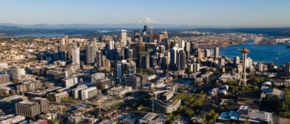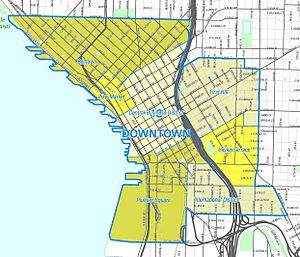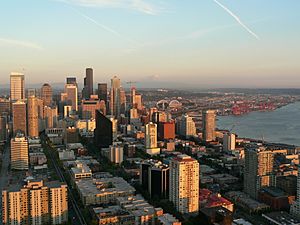Downtown Seattle facts for kids
Quick facts for kids
Downtown Seattle
|
|
|---|---|

Aerial view of Downtown Seattle, 2023
|
|

Downtown Seattle and Downtown Neighborhoods Highlighted in Yellow
|
|
| Country | United States |
| State | Washington |
| County | King |
| City | Seattle |
| Time zone | UTC−8 (PST) |
| • Summer (DST) | UTC−7 (PDT) |
| Zip Code |
98121
|
| Area Code | 206 |

Downtown Seattle is the main business area of Seattle, Washington. It's a very busy and important part of the city. It's quite small compared to other big city centers on the West Coast. This is because it's surrounded by hills to the north and east, the water of Elliott Bay to the west, and land that used to be muddy tidal flats to the south.
Downtown is bordered by Denny Way to the north. Beyond that are areas like Lower Queen Anne and Seattle Center. To the east, Interstate 5 separates it from Capitol Hill. To the south, S Dearborn Street marks the edge, with Sodo beyond. And to the west, you'll find Elliott Bay, which is part of Puget Sound.
Contents
Exploring Downtown Seattle
Cool Neighborhoods to Discover
Downtown Seattle is made up of several smaller neighborhoods, each with its own vibe. These include:
- Belltown
- Denny Triangle
- The main retail (shopping) district
- The West Edge
- The financial district (where banks and big companies are)
- The government district
- Pioneer Square
- Chinatown
- Japantown
- Little Saigon
- The western part of First Hill
Near the center of downtown is the Metropolitan Tract. This land is owned by the University of Washington. It was once the university's campus before 1895. Downtown is the heart of Seattle's business, shopping, and nightlife. You can even take a monorail from the Westlake Center shopping mall to Seattle Center.
Famous Landmarks and Buildings
Downtown Seattle has many impressive buildings and fun places to visit.
- The Columbia Center is a huge skyscraper with 76 floors. It's one of the tallest buildings west of the Mississippi River.
- The Smith Tower, located in the Pioneer Square area, was once the tallest building west of the Mississippi!
- Other famous buildings include 1201 Third Avenue, Two Union Square, and the main Nordstrom store.
- For music lovers, there's Benaroya Hall.
- The Seattle Central Library, designed by Rem Koolhaas, is known for its unique architecture.
- The main building of the Seattle Art Museum is also downtown.
You can also relax in several parks:
- Westlake Park
- Freeway Park
- Victor Steinbrueck Park
- The Olympic Sculpture Park opened in 2007 along the waterfront in Belltown.
One of the most famous spots is Pike Place Market. It's the oldest continuously operating farmers' market in the United States. It's a lively place with fresh food, crafts, and street performers.
In the early 1900s, downtown had many unique street clocks. These clocks advertised different businesses. Today, only four of these historic street clocks remain.
A Look Back: Downtown's History
The first settlers, known as the Denny Party, moved to what is now Pioneer Square in April 1852. They chose this spot because it had a safe, deep-water harbor. They first called the area "Duwamps." By the late 1850s, present-day downtown became the main residential area of the city.
After the Great Seattle Fire in 1889, much of the city was rebuilt. The business district then moved to this area. Starting around 1876, some of the city's hills around downtown were leveled or reshaped to make building easier.
Growing and Changing
Downtown Seattle's population has been growing steadily. In 2015, about 65,000 people lived in Seattle's core neighborhoods. Between 2010 and 2014, the number of homes and people living downtown increased by 8 to 10 percent. This growth was faster than the rest of the city. By the end of 2014, more than 5,000 new apartments and condos were being built.
In 1989, there were strict rules about how tall buildings could be in downtown Seattle. But these rules were changed in 2006. This allowed many new tall buildings to be constructed. Some people liked this because it meant more people could live and work downtown. Others worried it would make Seattle look too much like New York City, with too many skyscrapers.
As of 2018, Downtown Seattle was home to 82,000 residents. It also had 300,000 jobs, with 48,000 new jobs added since 2010, especially in the Denny Triangle area. Downtown has a huge amount of office space, about 71 million square feet. This is 79 percent of all office space in Seattle! Many new office buildings and projects continue to be built downtown.
Downtown's Economy: A Hub of Activity
Downtown Seattle is the biggest place for jobs in the entire Puget Sound region. In 2013, about 243,995 people worked there. This means half of all jobs in Seattle and 21 percent of all jobs in King County are located downtown. Several very large companies, known as Fortune 500 companies, have their main offices in Downtown Seattle. These include Amazon, Nordstrom, and Expeditors International.

